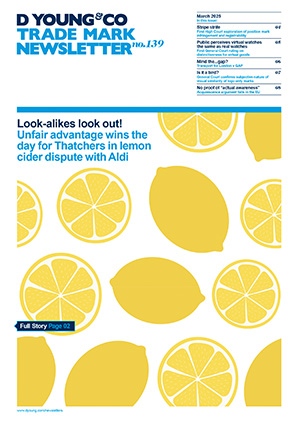LΛΛVΛ v EUIPO: interpreting characters within signs
The General Court agreed that there was no likelihood of confusion between LAV and LΛΛVΛ for identical goods, but the reasoning behind the decision differed to that of the Board of Appeal.
One of the differences concerned the interpretation of the characters within the sign LΛΛVΛ.
Background
The figurative mark LΛΛVΛ (see image below) was applied for as a European Union trade mark (EUTM) in classes 14 and 21.

An opposition was filed against “glass bottles containing mineral stones”, being all goods in class 21.


The opponent claimed a likelihood of confusion with its two earlier figurative EUTMs for LAV (figure 1) and Lav (figure 2), which covered goods including “glassware not included in other classes” in class 21.
At first instance, the opposition was rejected. The Board of Appeal agreed that there was no likelihood of confusion. The case was then appealed to the General Court.
Same outcome: different reasoning
As the earlier marks were EUTMs, the relevant territory was the EU in its entirety. In all instances, the Opposition Division, the Board of Appeal and the General Court held that the marks were similar only to a low degree and the goods were identical. This did not suffice to assume a likelihood of confusion. However, their reasoning differed. The primary points of difference were:
Why the level of attention of the relevant public was average to high
- The Opposition Division, Board of Appeal and General Court agreed that the relevant public would be the general public and the professional public in the EU. In addition, the level of attention of the relevant public was agreed to be higher than average.
- On the one hand, the Board of Appeal agreed with the Opposition Division that this was because glass bottles do not normally contain mineral stones and the stones could be precious or semi-precious. Therefore, the goods would be more expensive than ordinary glass bottles and purchased occasionally for long-term use.
- Conversely, the General Court considered the higher than average level of attention was because the relevant public only purchased bottles with mineral stones occasionally and for decorative purposes, or to obtain positive effects from the mineral stones. The court decided that mineral stones are not necessarily expensive.
How to perceive the characters within the contested mark LΛΛVΛ
- The Opposition Division described the contested sign LΛΛVΛ as containing the verbal element “LAAVA”, with the letter “A” depicted as an inverted letter “V”.
- The Board of Appeal however considered that LΛΛVΛ would not be perceived as “LAAVA”, but as containing a combination of both Greek and Latin letters including the Greek capital letter “Λ”, lambda.
- The General Court acknowledged that the part of the relevant public that speaks Greek would understand the symbol “Λ” as lambda, and that letters from the Greek alphabet are used in mathematics, science and engineering. But overall the General Court held that most consumers in the EU do not know the Greek alphabet. Therefore, the relevant public would perceive “Λ” as a stylised capital “A”, and would pronounce the contested sign as “LAA” “VA”. In support of this analysis, the General Court noted that the trade mark application form described the mark as “laava”.
Comparison of the marks
- The Opposition Division found the marks were similar only to a low degree.
- Reading the sign as containing both Latin and Greek characters led the Board of Appeal to conclude that the marks were similar visually and phonetically only to a low degree, and that conceptually a comparison was either impossible or the marks would be dissimilar.
- Reading the sign as containing only Latin characters led the General Court to conclude that the marks were similar only to a low degree, visually and phonetically. Again, conceptually the marks were either not comparable or dissimilar. It was noted that the earlier marks for “LAV” were short and the contested mark did contain stylisation that reduced the overall similarities.
Overall, the General Court confirmed there was no likelihood of confusion. Therefore, the appeal was dismissed.
In short
It is important to carefully consider the relevant public and their awareness of local language characters. Keep in mind that describing a word element on an application form can influence the likelihood of confusion assessment.
Where key marks contain (rare) local language characters it may be useful to also hold registrations in the relevant local language territory of the EU. These registrations can then be relied on in EU opposition proceedings, with the relevant public being the local language territory.
Case details at a glance
Jurisdiction: European Union
Decision level: General Court
Parties: Gürok Turizm ve Madencilik Anonim Sirketi v EUIPO (other parties: Gábor Darvas, Dorina Pap)
Citation: T‑473/22
Date: 13 September 2023
Useful link
LΛΛVΛ, EUTM file information, EUIPO, 12 March 2020: dycip.com/eutm-018209861

